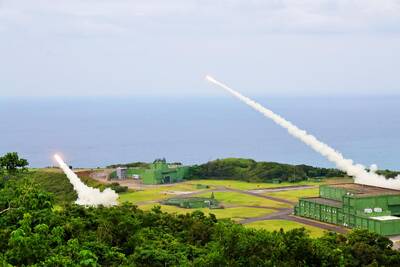The nation's work in preserving its intangible cultural heritage received a boost yesterday when the Council of Cultural Affairs penned a memorandum of understanding with the Pacific Islands Museums Association to increase exchanges between museums in Taiwan and Oceanic countries.
The director of the National Taiwan History Museum, Wu Mi-cha (吳密察), said that although Taiwan was the root of the Austronesian ethnolinguistic family, it had much to learn from its Pacific counterparts.
Unlike museums in the Pacific islands, where the preservation of intangible culture is highly valued, Taiwan focuses mainly on preserving tangible artifacts, he said.
"Pacific island museums are also very keen to preserve their indigenous cultures. But here we often look outward to introduce foreign cultures, and do not look inward enough to showcase our native culture," Wu said.
Museums on the Pacific Rim are neighborhood-friendly and are closely involved with the community, whereas museums in Taiwan are frequently dissociated from the public, he said.
Pacific Islands Museums Association secretary-general Meredith Blake said she was impressed by the high level of professionalism of Taiwanese museum workers and hoped the memorandum would strengthen working relationships and expand mutual research.
Blake added that the association hoped to take advantage of Taiwan's digital capacity to help the museums better organize their collections.
The association is a regional, multilingual and non-profit organization consisting of more than 20 countries.
The Council of Cultural Affairs and the Pacific Island Museums Association will hold an international symposium on intangible cultural heritage preservation tomorrow at the National Museum of Taiwanese Literature in Tainan City.
More than 13 museum directors and cultural preservation experts from Taiwan and eight Pacific island countries -- Tonga, New Caledonia, Fiji, Samoa, the Solomon Islands, Vanuatu, Palau and Papua New Guinea -- will contribute to the discussion.

Trips for more than 100,000 international and domestic air travelers could be disrupted as China launches a military exercise around Taiwan today, Taiwan’s Civil Aviation Administration (CAA) said yesterday. The exercise could affect nearly 900 flights scheduled to enter the Taipei Flight Information Region (FIR) during the exercise window, it added. A notice issued by the Chinese Civil Aviation Administration showed there would be seven temporary zones around the Taiwan Strait which would be used for live-fire exercises, lasting from 8am to 6pm today. All aircraft are prohibited from entering during exercise, it says. Taipei FIR has 14 international air routes and

Taiwan lacks effective and cost-efficient armaments to intercept rockets, making the planned “T-Dome” interception system necessary, two experts said on Tuesday. The concerns were raised after China’s military fired two waves of rockets during live-fire drills around Taiwan on Tuesday, part of two-day exercises code-named “Justice Mission 2025.” The first wave involved 17 rockets launched at 9am from Pingtan in China’s Fujian Province, according to Lieutenant General Hsieh Jih-sheng (謝日升) of the Office of the Deputy Chief of the General Staff for Intelligence at the Ministry of National Defense. Those rockets landed 70 nautical miles (129.6km) northeast of Keelung without flying over Taiwan,

City buses in Taipei and New Taipei City, as well as the Taipei MRT, would on Saturday begin accepting QR code payments from five electronic payment providers, the Taipei Department of Transportation said yesterday. The new option would allow passengers to use the “transportation QR code” feature from EasyWallet, iPass Money, iCash Pay, Jkopay or PXPay Plus. Passengers should open their preferred electronic payment app, select the “transportation code” — not the regular payment code — unlock it, and scan the code at ticket readers or gates, General Planning Division Director-General Liu Kuo-chu (劉國著) said. People should move through the

The Ministry of National Defense (MND) today released images of the military tracking China’s People's Liberation Army (PLA) movements during the latest round of Chinese drills around Taiwan. The PLA began "Justice Mission 2025" drills today, carrying out live-fire drills, simulated strikes on land and maritime targets, and exercises to blockade the nation's main ports. The exercises are to continue tomorrow, with the PLA announcing sea and air space restrictions for five zones around Taiwan for 10 hours starting from 8:30am. The ministry today released images showing a Chinese J-16 fighter jet tracked by a F-16V Block 20 jet and the